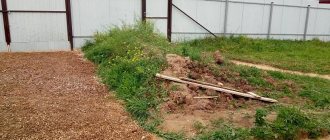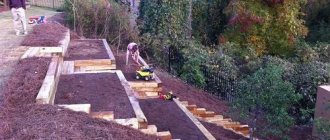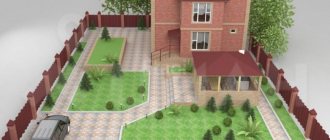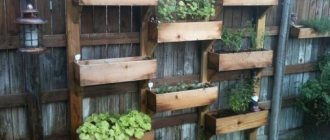Review author: Terrari School of Design
Not everyone is lucky enough to buy a suburban plot with ideal soil. Very often, a wetland or an area with a high groundwater level comes into possession. In this case, the question arises of how to dry the area from water with the least financial costs and minimal loss of time during the process.
There are two main options - carrying out drainage work, and without carrying out such work.
Drying without drainage
This is an environmentally friendly method that is harmless to the environment and humans. The only drawback is that it takes quite a long time.
The process is simple and easy. It is necessary to plant plants that drain the area. This:
- willow;
- maple;
- birch:
- ate.
Poplar and alder absorb excess moisture well, but it is not recommended to plant them in a suburban area - their fluff can cause allergic reactions.
A pleasant additional bonus of this drainage method will be the decoration of the garden with beautiful plantings.
In addition to trees, you can opt for shrubs, such as:
- rose hip;
- hawthorn;
- irga.
By planting these species around the perimeter of your estate, you will get a spectacular hedge.
Some types of flowers can also be used for drying:
- perennial asters;
- aquilegia;
- swamp iris
Flowers such as hydrangea, Amur lilac, and mock orange are also effective natural dehumidifiers. True, they can help if the level of swampiness in the area is not very high.
Imported soil
If the cause of waterlogging is heavy soil, then adding fertile soil to it can improve the condition of the site. The water will go deeper, leaving the top layer of soil suitable for growing garden crops. As practice shows, swampy soils retain their fertility for a long time and do not require additional fertilizers for several years.
If you don’t plan to actively cultivate garden crops on your personal plot, then you can come to terms with the swampiness of the area; it’s enough to improve it. In waterlogged soil you can grow rhododendron, thuja, lingonberries, hydrangea and many other beautiful and useful plants. Thus, you can turn the site into a beautiful corner for rest and relaxation.
Drainage
Let's consider five options for draining the site. This:
- surface drainage;
- creation of a closed system;
- reducing moisture levels with wellpoints;
- with the help of moisture-loving plants;
- increasing the level of a place overflowing with moisture.
Let us immediately note that it is unlikely that a person unfamiliar with these technologies will be able to drain the area with his own hands, creating a closed drainage system or using wellpoints.
To create a closed drainage system, you need not only special knowledge, but also professional equipment. True, this system is the most effective and takes up virtually no space on the site, because all its elements are underground. If you want to have this effective method of drying, you need to contact specialists.
It is also impossible to do without the involvement of professionals when draining swampy areas or lowering the groundwater level using wellpoints. In addition to laying the pipes, it is necessary to secure the appropriate equipment at their ends, protect it from soil, and connect it to a vacuum pump.
Such a system lowers the groundwater level to five meters, and removes excess moisture in wetlands to a level of twenty meters. Let's look at the methods that you can do yourself.
Construction of ponds, sewage pits or ditches
Owners of country houses are often interested in how to dry a plot of water with their own hands without drainage. This is also possible, but it is best to use such methods in the country, and not in a country house. This is digging ditches, sewage pits or decorative ponds. They can become not only a means of draining water, but also an element of landscape design.
The choice of method depends on the characteristics of the site and the reason for the accumulation of moisture.
Note! The disadvantage of this method is the need to regularly clean the resulting reservoirs. Without this, they will bloom, mosquitoes will appear, and there will be an unpleasant smell.
Determining the need for drainage
A visual way to determine high humidity in an area is the growth of plants such as sedge or reeds. Puddles that do not dry out for a long time after rain are a signal that there is a lot of other moisture in the soil.
There is another simple way - you should dig a hole up to half a meter deep. If after some time water appears at the bottom, then drainage work needs to be done on the site.
Surface groundwater drainage
Waterlogged soil can be drained using ditches. Excess liquid must be directed to storage pits. The depth of the ditches should be between 40 and 80 cm.
The advantages of surface removal of excess moisture include: low cost, high speed of work.
The disadvantage of this method is the constant shedding of the gutters. The owner of the site has to regularly clean the channels of silt.
Types of drainage systems
Among those processes for draining a site that can be carried out independently, linear and point drainage are distinguished.
When carrying out linear type work, it is necessary to dig trenches around the perimeter of the site up to a third of a meter deep. Then they should be covered with gravel. The disadvantages of such drainage are its unaesthetic appearance and systematic work to clean out various types of debris.
Point is the simplest type, requiring neither special knowledge nor complex calculations. Simply, drains are installed in places where water stagnates.
Features of wetlands
Before you begin draining a wetland
, it is necessary to determine the type of swamp. It can be lowland or upland.
In the first case, the swamp is located in the natural lowland of the site and excessive moisture here is a consequence of the close location of groundwater. As a rule, the soil in such an area is fertile, but perennial plants do not take root well and disappear after a few years.
Raised bogs can appear even on the top of a hill. The reason for this is the inability of the soil to pass through itself moisture coming with precipitation. Most often, such areas are represented by clay soil, which does not allow water to seep to the lower soil layers.
Deep system
A closed system is a more complex, but very effective way to get rid of excess moisture in the area. It can be used to lower the groundwater level.
For such drainage, it is necessary to lay special PVC pipes in the ground with holes into which water will flow. The ditches themselves should have a slope ending at the drainage wells.
Conclusions about the main thing
There are several ways to drain a plot of land yourself, but if you are not ready to carry out heavy excavation work and do not have sufficient experience and knowledge, it is more effective to entrust this to specialists.
To choose the right drainage, the following factors should be taken into account:
- soil composition and permeability;
- dimensions and shape of the pit for future construction, weight of the building;
- groundwater level depending on the season (the highest value is applied);
- the possibility of seasonal floods due to melting snow and autumn precipitation;
- speed of movement and direction of groundwater.
All factors can be foreseen only after a geodetic analysis of the soil; in some cases, test drilling is used.
Progress
The work steps should be carried out in this order:
- Prepare a plan with precise locations of trenches. Please note that they must be at least two and a half meters away from trees.
- Dig ditches.
- Place a ten or fifteen centimeter layer of sand at the bottom of the prepared trenches.
- Lay waterproof material – geotextiles.
- Place the pipes.
- Fill the remaining space in the ditches with gravel, so that about twenty centimeters remain to the ground.
- Cover the surface with geotextile and fill it with small stones and soil.
By following these instructions for draining the area, you will forever forget about excess moisture in groundwater.
Disguise as design - ponds, streams
If groundwater lies at a high level near the surface, and its quantity is large for the drainage system, you can use the water to decorate the site. If the territory of the dacha is flat, then the pond will look good, and if the site has a slight slope, you can organize a stream with your own hands to drain the water.
To create an artificial reservoir to collect water in order to drain the area, you will need to dig a hole or lay a trench, forming a stream bed. Line the bottom of the ditch with construction geotextiles.
Sunny areas are not recommended for the construction of artificial ponds, since groundwater often blooms from the sun, and the pond will have to be cleaned much more often.
Getting rid of the swamp
An unpleasant smell from fumes, clouds of blood-sucking mosquitoes - these are the delights that await the owners of country cottages located in swampy areas.
You can get rid of the scourge only by completely removing moisture from the swamp. One of the possible options - planting plants that absorb moisture, has already been discussed in this article. Let's look at other methods.
Extreme measures
If none of the described methods of reclamation gave the required result, or you simply do not want to wait, you can call specialists. With the help of powerful pumps, it will be possible to pump out unnecessary liquid in a short time, and the effect will be noticeable within 24 hours. But such a service is quite expensive, and the problem of waterlogging may return after a while. If you were unable to win due to dry soil, you can resign yourself and use the moisture in the soil to your advantage. To do this, you can start arranging a pond, surrounding it with beautiful plants that require moisture.
In humid conditions, viburnum, blueberries, cranberries, buttercups, marsh iris, thuja, and heather will grow magnificently. An excellent addition would be maiden grapes, callas, lush ferns, and some varieties of orchids. There are many methods for dealing with excess moisture in the garden, but if none of them can help, you will have to create your own corner of nature. The owner of a swampy plot can successfully grow garden flowers and crops, but also build a house. There are many solutions for this.
Versailles variant
The residence of the French kings, which still amazes visitors with its beauty, was located on a marshy area. The famous Cross Canal was dug in order to drain excess moisture into it. We don’t suggest digging an imitation of the Versailles canal, but any summer resident can easily create a decorative swamp.
In summer, moisture will evaporate and the water level will drop significantly. During the rainy season there will be more moisture in the swamp.
One very significant advantage of such a reservoir is that there is no need to do the waterproofing necessary when designing other decorative water surfaces on the site.
Well
Another option for draining a swamp on a site is to make a waterproof well. You can build a well from concrete or from a large plastic container.
The well should be protected from clogging with geotest material. The water accumulated in the container can be used for irrigation or pumped out with a pump and discharged through laid pipes outside the site.
You can build a drainage system yourself, following the instructions given above. The cost of such work will be low, but the effect will be quite significant.
Useful tips
Ideally, if you decide to create a drainage system, you should do this not in the fall, but exclusively in the dry season, for example, in the summer.
Of course, it is possible in the fall, but be prepared for the fact that you simply will not be able to create a high-quality trench, since there will be a large amount of water on the site, which you just need to get rid of.
It is necessary to determine the most optimal depth in order to retain groundwater and then begin laying a drainage system, which must necessarily be below this mark.
Today, many owners of suburban areas make the same mistake. They install the drainage system absolutely correctly, but do not pump out the water at the required frequency.
In this case, the drainage becomes absolutely useless after a couple of months.
When creating a system, you need to be extremely careful. Very often, unprepared people can fall into a well or drainage holes. Therefore, to avoid injury, pits must be covered.
Backfill
You can get rid of moisture by pouring a layer of sand over the entire area of the site. You need to start working by determining the highest point. It is necessary to take into account that you will need to raise the level by at least twenty centimeters.
Having calculated the required cubic capacity of the material, you should purchase construction sand and gravel. Sand, lying on the ground, squeezes out excess moisture, and its high drainage ability does not allow water to accumulate on the surface.
The final stage of the process - a fertile layer of soil is laid on top of the “pie” of sand and gravel on which any crops can be grown.
Rules of care
Drainage structures will function properly for many years if the basic rules are followed during operation :
- the top layer of soil must remain loose throughout the entire time so that moisture is absorbed as best as possible, which means moving heavy equipment directly over it should be prevented;
- collectors and wells must be regularly cleaned of contaminants, otherwise maintaining the system may be difficult;
- Pipelines should be cleaned every 10-15 years.
The choice of cleaning method largely depends on the location of the drains and their design features. Contaminants from elements located on the surface can be removed manually without the involvement of professionals. If the components of the system are deepened into the ground, then the measures become more complicated.
The work may require a special installation with a cleaning roller that can remove deposits from the internal surfaces of the pipes.











